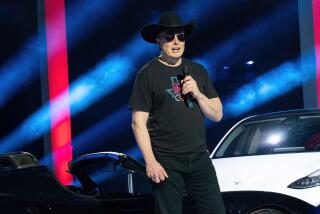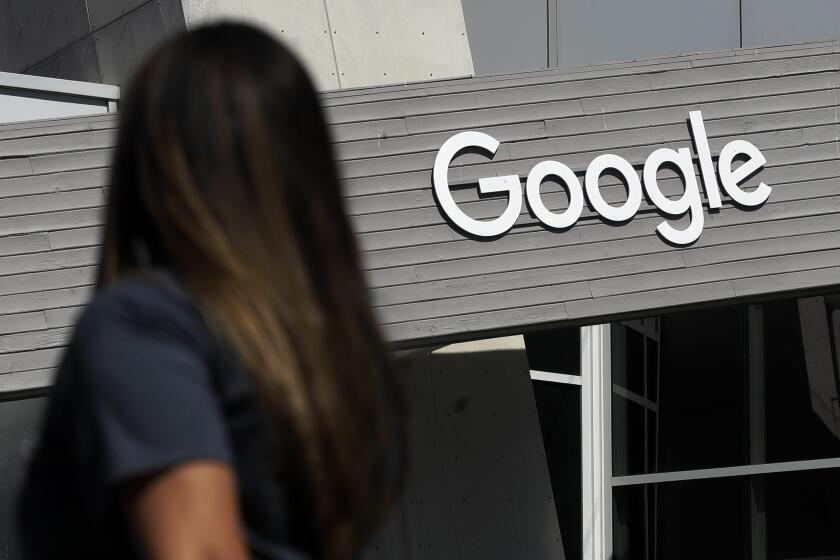Facebook settles into new home just days before expected IPO filing
- Share via
Reporting from San Francisco — Apple Inc. has 1 Infinite Loop and Genentech Inc. has 1 DNA Way. But Facebook Inc. now lays claim to Silicon Valley’s premier vanity address: 1 Hacker Way.
After journeying from a Harvard dorm room to a rented house in Palo Alto to a series of temporary corporate offices it quickly outgrew, the 8-year-old social networking giant has set down permanent roots just in time for its initial public offering.
And its splashy new campus in Menlo Park has quickly become the envy of its Silicon Valley neighbors.
PHOTOS: On the Facebook campus
Facebook, the hottest company to come out of the region since Google Inc., is expected to file papers this week to sell its stock to the public in an offering that could raise $10 billion and value the company as high as $100 billion.
On a recent afternoon the 57-acre campus hummed expectantly as more than 2,000 employees, about half of whom will probably become instant millionaires, were still settling in to their new digs. In all, the company has more than 3,000 employees in 35 offices in 20 countries.
Thirty miles south of San Francisco on the edge of tidal mud flats and salt marshes, the nine-building complex has room for up to 3,600. The company is seeking approval from Menlo Park to boost its head count to as many as 6,600. It has campaigned for months to win over the nearby largely Mexican American neighborhood of Belle Haven and show that it will be a good neighbor to clear the way for its expansion.
The former home of Sun Microsystems was dubbed “Sun Quentin” because it’s bordered by water on three sides and by the Bayfront Expressway on the other side.
Facebook even bought a 22-acre site for a companion campus it plans to build on the other side of the divided highway that can be reached through an underground crossing that is wide enough for cars. Facebook will install a people mover in the crossing to ferry its staffers back and forth to the new campus that it hopes to have ready by 2014. The two campuses will give Facebook room for as many as 9,400 employees.
It’s all part of founder and Chief Executive Mark Zuckerberg’s drive to create an urban oasis for staffers, part of its take-no-prisoners effort to one-up its chief rivals such as Google in the heated wars for top engineers and executives.
“We are creating the new urban place to work,” said Facebook real estate chief John Tenanes.
Tenanes showed off slick maps of Facebook’s expansion plans in a conference room named Charlie Bit Me after the viral YouTube video. Employees voted on the irreverent themes for conference rooms. Ties resulted in mixed concepts such as drinks and “Star Wars”: Darth Jager, Skyywalker and Whiskey on the Ewoks.
Little remains of the more staid former Sun Microsystems, which favored private offices, wall-to-wall carpeting and glass-walled conference rooms.
Facebook has ripped open ceilings and walls to expose steel girders and ductwork, and peeled back carpets to concrete floors polished with swirls. There are no cubicles or offices, not even for Zuckerberg, just long tables with super-high-IQ workers plugging away.
That means Facebook can accommodate more staffers on the 1-million-square-foot campus than Sun did, Tenanes said. Sun dedicated about 270 square feet to each staffer, while Facebook dedicates just 150 square feet, Tenanes said. That helps Facebook use about 30% to 35% less energy, he added.
“Hack” has been doodled and scribbled on walls covered floor to ceiling in chalkboard paint in the real-life equivalent of Facebook users’ walls. (At the entrance to Facebook’s campus stands a giant wood sculpture that Facebook staffers created during a recent hack-athon that spells out “hack,” Facebook’s motto of moving fast and breaking things.)
Graffiti artist David Choe tagged the walls of the building that houses Zuckerberg and other Facebook executives. Breakaway spaces that Facebook calls “cozies” pop up everywhere for spontaneous meetings. Micro-kitchens stocked with typical Silicon Valley fuel — Red Bull, chips and other snacks — are strategically placed throughout the buildings so that no employee ever goes hungry. Vending machines dispense free soda or computer accessories.
Employees can even hit the full-service bar Friday afternoon. The Shady Lady features an old-school vinyl bar purchased on Craigslist. Or if they are feeling nostalgic, they can sit down at a gray mid-century metal desk topped with a Royal typewriter.
The main attraction especially around noon is the first of two cafés to dish up gourmet grub from top chefs. It sports the design of a circuit board to efficiently and quickly flow 2,000 people in and out in an hour and change. Food carts serving such delicacies as Korean tacos roam the campus.
The focal point of the campus is a leafy central courtyard that Sun Microsystems filled with manicured greenery that gave it the feel of an English garden, Tenanes said.
Facebook uprooted and replanted elsewhere the Italian plum trees and other assorted plants. Now a road still covered in construction dust and equipment slices through the 1,200-foot-long courtyard lined with half-painted low-slung stucco buildings. By March the transformation from corporate courtyard to urban main street will be complete. It will be lined with storefronts shaded by awnings.
Employees will stroll on sidewalks or ride bicycles and RipStiks (two-wheeled skateboards) down the middle of the street to a noodle joint, a bike shop, Philz Coffee stand, a dry cleaners, computer help desk, even a burger shack that some have dubbed Zuckerberger’s even before it opens for business. In a nod to Facebook’s original digs on University Avenue in downtown Palo Alto, Zuckerberg even joked about opening an Oriental rug store permanently going out of business.
About halfway down will be an outdoor amphitheater with a Jumbotron that can hold 500 for movie nights or big company announcements.
One thing that still lingers from Sun Microsystems: All the doors, which Facebook recycled, some of which still bear the logo of the company that used to burn so brightly in Silicon Valley but was bought out by Oracle Corp. in 2010. It’s a subtle reminder of what can happen to companies that don’t stay on top of their game.






